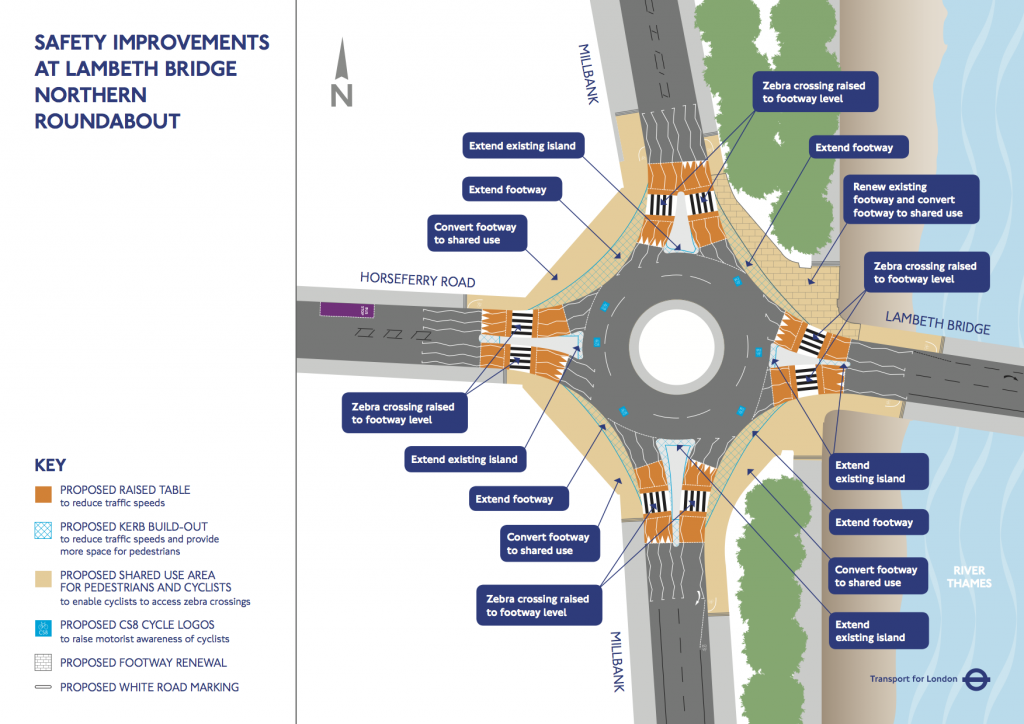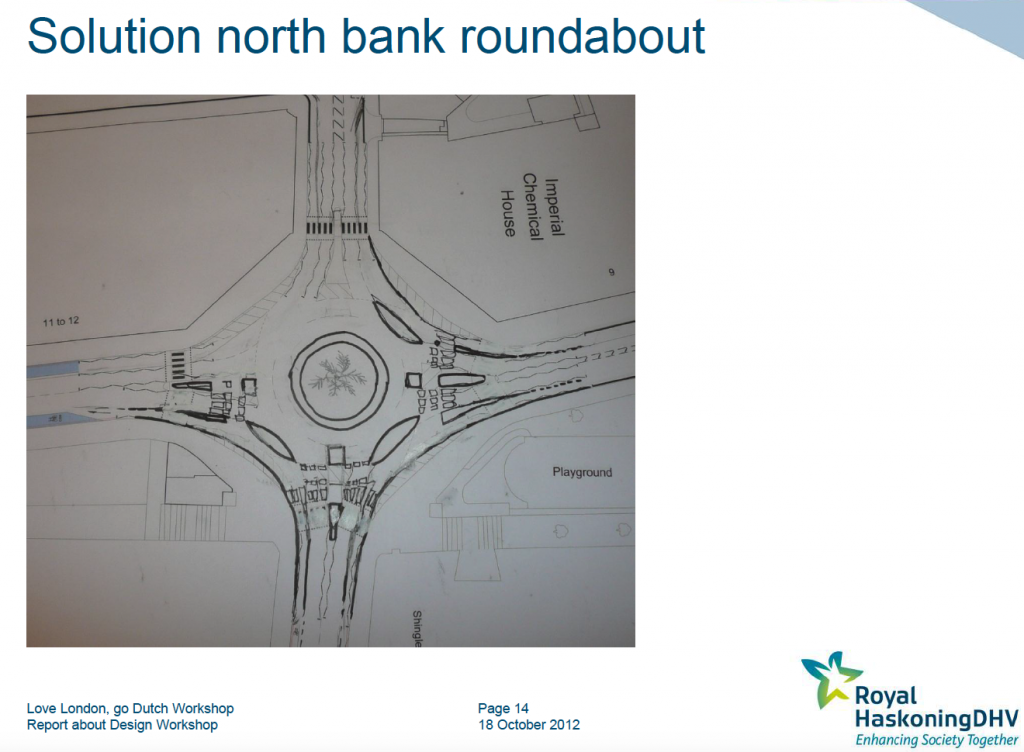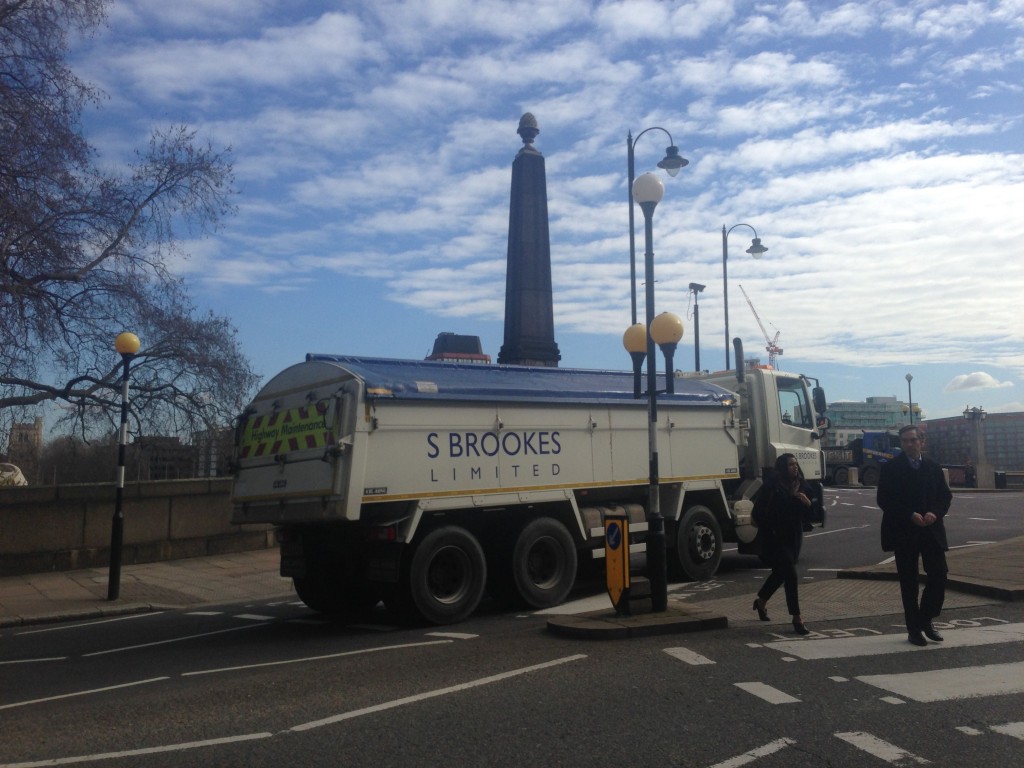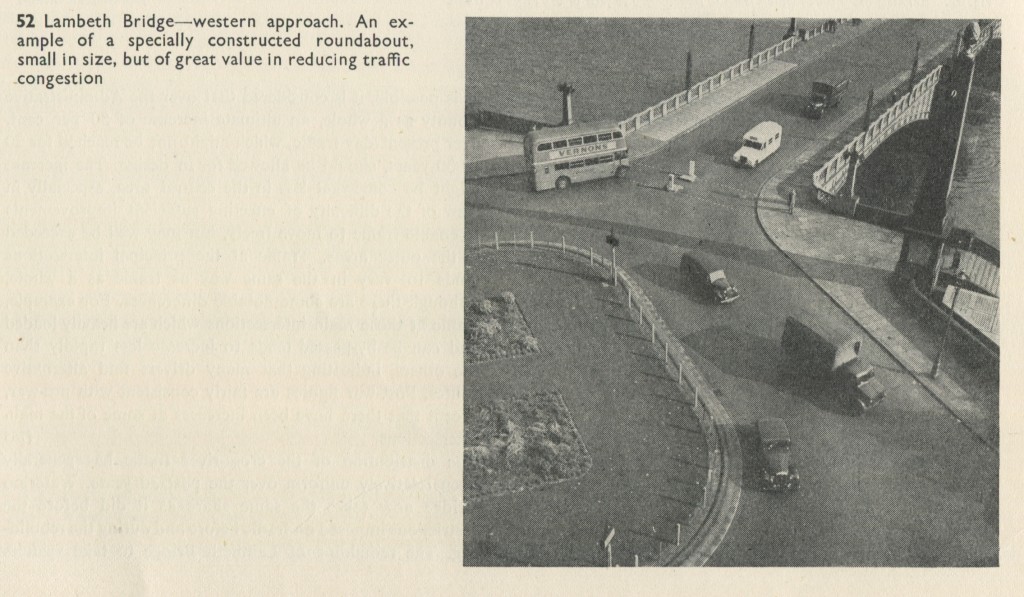When can Lambeth Bridge finally Go Dutch?
On Thursday, Moira Gemmill, a 55 year old former director of design at the V&A museum was killed after a collision at the Millbank roundabout on the northern end of Lambeth Bridge. The obituaries and news reports are sobering reading.
Beyond the anger at the death itself, there is obviously the question of why. The roundabout at Lambeth Bridge is a known danger spot, which has seen high profile plans for change that were not followed. So what’s the history?
The roundabout went in as part of a reconstruction of the Lambeth Bridge, completed in 1932. The bridge was originally four lanes wide, but over time was narrowed to three lanes. Here is the junction in 1946:
It’s worth zooming in to see the junction more clearly, you can see it has no pedestrian crossings and two rather large trucks going around it. It’s also clear that the circulatory carriageway is paralleled by a wide section enabling direct and fast left turns.
In the 1951, County of London Plan the roundabout was highlighted as a “specially constructed roundabout, small in size, but of great value in reducing traffic congestion”. Road studs can be seen marking a pedestrian crossing.
By 1984, zebra crossings had been added, the broad island remained and road markings had started to appear on the approaches.

In 1995, the stretch of road from this junction to the Houses of Parliament was mentioned in a point of order. Two MPs noted that there had not only been a collision with the police attending but that vehicles were continuing to drive through at speeds they estimated as being over 50mph. It was suggested that some better lighting might help!
By 1996, the new smaller circular central island had been put in place, as this vintage photo shows.
Then by 1999 the bridge was narrowed to three lanes and the roundabout at the northern end visually narrowed using painted hatchings. And that’s how it is now. In about 2002 Transport for London (TfL) formally took control of the junction, along with Lambeth Bridge and Millbank to the south from Westminster. We should also note that the Department for Transport who set the regulations and framework that both Westminster and TfL work within are based just along Horseferry Road.
It appears that the junction was assessed in some form for cycling in both 2002 and 2005, with a scheme in 2005 to have involved toucan crossings and cycle lanes on approaches said to have been “awaiting funding”. None of these came to be. The most recent discussions on this layout were in 2012 when TfL proposed to make some safety improvements. This was part of a junctions review started in late 2011 after high profile deaths in London at locations such as Bow Roundabout. In July 2012 TfL explicitly named Lambeth Bridge northern roundabout as one of the junctions to be redesigned. Already at that time TfL was clear that it needed to be able to do things that were not permitted by DfT in order that it could make sufficiently safe designs.
TfL consulted on their design for Lambeth Bridge northern roundabout in October 2012. It used raised tables to slow traffic on entry. If you compare this scheme to the hatchings above you can see it also moved kerbs out to match them, so that would have had limited effects on speeds. TfL then proposed to use this extended footway as shared space with cycling over the footway and zebras. The use of cycling over the zebra crossings was itself of note as it involved recognising that drivers usually gave way to cycles on a zebra crossing whilst ignoring that regulations did not permit it. At the same time there were to be the then customary blue splodges of superhighway marking to raise motorists awareness of cyclists. No explicit priority was being given to cyclists but the use of raised entries was to help imply it.

In essence this was a standard example of the approach of using traffic calming and urban realm techniques to provide for cycling. These were at the time the classic approaches to providing for cycling being used in much of the UK.
The consultation attracted a lot of feedback and received only 6.8% support. 137 respondents requested a (kerb) segregated cycle facility, clear space for cycling at this junction not shared space with pedestrians or paint suggesting the presence of cycles. In short, TfL’s scheme was phenomenally unpopular.

The kerb build outs also received a particular disagreement. This appears to have been due to the Motorcycle Action Group (MAG), whose concern was that “hatched areas act as a refuge for motorcyclists, and that paving over them would reduce safety”. It is unclear what evidence was provided for this claim though motorcycle press reported the cancellation as a victory.
Far easier to explain are the objections of the cycling community. These were widely and clearly written about at the time and helped inspire the scale of the disapproval TfL received. During the consultation a design workshop was held that helped devise an example Dutch approach.

The solution the workshop devised was to use a roundabout with clear space for cycling as seen in the Netherlands. This was used as part of the objections from various cycling groups such as the local LCC group and the Cycling Embassy of Great Britain, explained in more detail by Mark Treasure.
At the close of the consultation, TfL commented as follows:
Having considered responses to consultation, and following concerns voiced by Westminster City Council, we have decided not to proceed with these planned initial improvements at Lambeth Bridge northern roundabout. Instead, we will concentrate our resources on developing more substantial improvements that meet the expectations of Westminster City Council and other stakeholders.
Some of the measures suggested by respondents, such as a segregated cycle track around the outside of the roundabout with cyclist priority at slip roads, would be new features on London’s roads, and therefore require off-street trials. We have started building the infrastructure for these trials at the Transport Research Laboratory in Berkshire, and we will work with our stakeholders to ensure their views are considered as part of this work. Suggestions made as part of this and other consultations will be considered by the team planning the trials.
Trials were necessary because the DfT would not permit these designs to be trialled in situ. As Peter Hendy of TfL said in response to the London Assembly Transport Committee in April 2013 the outcome depended on the trials and the UK government response:
We are already conducting off-street trials of innovative facilities (such as eye-level traffic lights or “Dutch-style” roundabouts) which may help cyclists. If the trials are successful, and the Government permits, we will roll these out on the road network.
The trial roundabout was built in 2013. I and many others helped with the testing of it. It felt remarkable to see and ride, and compared reasonably well with equivalents on the continent though UK regulations seemed to have given it an outstanding number of belisha beacons.
The junction works because of the large islands which are designed to place vehicular traffic crossing over the roundabout and cycle traffic crossing on the circular cycle track into each other’s direct vision. The triangles on the carriageway denote a give way marking in the Dutch style which in this case gives the cycle track similar priority to that of a pedestrian zebra crossing (which sits immediately behind). This – to an extent – formalises the behaviour TfL expected from their shared use scheme, but also makes it safe and prioritised sufficiently that it is suitable for anyone on a bike.
To date, unlike several other trials TfL undertook at the same time, the Transport Research Laboratory has yet to publish the results of this trial. TfL themselves have not proposed such a junction anywhere in London to date. It is sensible to compare TfL’s trial junction with experience in the Netherlands, as Mark Wagenbuur has.
But the trials obviously happened in parallel with other work on cycling. It’s worth a brief examination of those. In 2013 the Mayor’s Cycling Vision was announced and it recast the better junctions programme from reworking 100 junctions to just 33 junctions within a budget of £100m. TfL had recognised, belatedly, that reworking junctions for cycling would not be cheap if it was to be done properly.
Also in 2013 Westminster Council was working on a cycling strategy, and one published draft said:
TfL has met with Council officers to discuss plans for two of the first locations within the City of Westminster to be considered as part of its Better Junctions Review. The first is the Lambeth Bridge North/ Millbank roundabout and the second is the gyratory system near Victoria Station. Officers have raised concerns over the initial proposals presented for Lambeth Bridge North and has asked TfL to revise its proposals before re-engaging with the appropriate stakeholder groups, including the Council and pedestrian and cycle groups. Similarly, TfL has undertaken a site visit with Westminster officers to seek views on various proposals for junctions and sections of road around the Victoria gyratory. However, establishing viable solutions in the short term whilst construction works continue will be a challenge. There are also a number of other junctions in Westminster (on the Transport for London Road Network) that are under review, but no details are yet available.
Note that the Victoria Station gyratory is where the previous London cycling death occurred. This rather detailed reference was removed from the final Westminster Cycling strategy which was as follows:
TfL has been carrying out a ‘Better Junctions’ review of the most dangerous junctions on its network. Some arms of these junctions fall on Westminster’s highway, and the Council will
be working in partnership with TfL to develop appropriate solutions for each location. The locations within the City of Westminster that fall outside the remit of the East West
Superhighway are:
– Marble Arch gyratory
– Great Portland Street gyratory
– Lambeth Bridge roundabout
Just as TfL is carrying out its Better Junctions Review for the TLRN, the Council also intends to review at least annually where accidents involving cyclists are taking place on Westminster’s streets. This will be compared with data showing accidents involving other road users and appropriate solutions will be developed where feasible.
Meanwhile other councils had obviously taken note of the potential opportunities to provide in new ways for cycling. In Southwark, right at the South of the borough where it meets Lewisham, Bromley, Croydon and Lambeth nearby to Crystal Palace they proposed a pair of roundabouts with segregated tracks, essentially the first proposal to feature something nearing a Dutch style roundabout with separate cycle track.
I’m not sure if these have been formally approved, but the consultation report was clearly positive and recommends the scheme goes ahead. The Croydon Cycling campaign came out against the plans as presented, The Cycling Embassy of Great Britain also noted several reservations despite the ambition being shown. So we get closer, but we still haven’t yet got these things entirely right. Note the way that cycles are made to give way at the exits of cycle tracks and the potential for vehicles to maintain high speeds whilst executing many movements through the junction. Even when this junction is built, a typical roundabout in the Netherlands would still be much safer.

So turning back to Lambeth. The northern roundabout is by no means exceptional, perhaps other than in location and prominence in campaigning history. There are junctions of this nature throughout the UK. The fatal collisions at them are statistically rare, but important as the feeling of a lack of safety is predominantly what puts people off cycling. Everyone says they want more cycling (well, perhaps except MAG), but there seems to be a remarkable lack of urgency and curiosity here.This death was predictable. What is holding us up from making it preventable? Let’s consider some of the bodies involved in turn.
Westminster Council had control of this junction until comparatively recently. It seems likely that they were the authority that remodelled the central island and visually narrowed it with paint. And yet, they now seem resistant to having kerbs match that narrowing and are siding with the relatively unheard of MAG. There is no clear vision or alternate approach being put forward by them and they appear to be sat back waiting to see what TfL do. This is in marked contrast to the approach of boroughs elsewhere in London. Westminster Council is meant to be delivering a huge proportion of the Central London Grid, but it seems clear from a variety of comments that it is not yet felt to be proposing suitable quality routes.
Transport for London is only just starting to deliver on the Mayor’s Cycling Vision and it is still below the vision imagined in the ‘Go Dutch’ principles signed up to in 2012. TfL’s board was more interested in trying to stop the major East-West superhighway from happening than scrutinising it’s responsibilities in making the roads safer for cycling. They are coming under sustained opposition from some areas in the taxi trade and from motorcycle groups, along with certain corporate powers in London. That TfL and the Mayor have broadly kept their course is at least something. However, it is simultaneously true that TfL is doing more for cycling than it has ever done before and that it still isn’t on track to do enough. Some of that is about money from central government but some is about political will on power and money already in its hands. In some locations it hasn’t had the power to push through safer designs when local councils have blocked them. but with this junction being on their network that doesn’t seem to apply.
The Department for Transport seems to me to be running at two speeds. There is the clearly politically led drive towards more road building, typically outside of major urban areas but often near and close to smaller towns. Does the DfT understand that that the issue isn’t with a few roundabouts in a few locations but probably every roundabout and almost every junction? It seems close to inevitable to me that as the ‘cycle proofing’ group DfT has set up gathers best practice that it will point to a need for a further rewrite of both the regulations and most urgently the design manual for cycling, which is unchanged since 2008. In the meantime DfT have started pointing to the rewritten London Cycle Design Standards and their similar cousin in Wales. The incoming government must use their political clout to get DfT to recognise the issues in much of UK road design and get them fixed all the way from concepts to execution.
Whatever design TfL is working on, that it’s had to trial and that the DfT may or may not approve, it’s not due until at least the end of 2016. That will be four years after the 2012 proposal and as much as fouteen years since the earliest evidence I can find of it being appraised for cycling. By about 2020 it’s likely that the Houses of Parliament will see major building work, thus increasing the heavy goods traffic in this area. So, when is Lambeth Bridge northern roundabout going to finally Go Dutch?








Thanks for this calm and comprehensive response. Time indeed to do rather than fiddle. Clearly much needs to be done with MAG, as CEoGB seems to be doing with GDfB,
Graham
Good article, but way too long to have to wade through, so it should be edited right down to the nub. Many people will not bother to read through it, since I can’t be the only cyclist/motorist who doesn’t care that a roundabout was installed at Lambeth Bridge in 1932, or about the numerous changes there since. I’m interested in its current layout and what might be done to improve safety there. It would be sensible to start with the TfL’s proposals in 2012, why they weren’t implemented and the options possible now.
It’s purposely long, and about an extra third was edited out.
I wasn’t seeking to address the preferred layout now, but I might do that as a later post.
A very interesting and enlightening article, thanks. The M.A.G (“Motorcycle Action Group”) are very well known to the City of Westminster because they tried to resist the fees for parking motorcycles on the street. They say they had 4,000+ motorcyclists from all over the UK protesting and bringing Victoria and Trafalgar Square to a standstill, so they are not really “relatively unheard of”. It is therefore no wonder that Westminster would try to keep M.A.G on-side. wee also http://www.nobikeparkingtax.com
Pingback: April rides and events in Waltham Forest | Waltham Forest Cycling Campaign